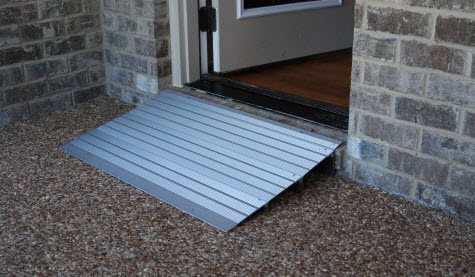8 Tips to Make Your Home Wheelchair Accessible
Posted on by Chris Frombach
At some point, due to age or disability, you or a loved one may be faced with the prospect of having to use a wheelchair to assist in your primary mobility at home. Whether it be a temporary fixture to your home or something that will be more permanent, there are a number of simple modifications that can help improve accessibility and make life easier.
 If you are like most people, you live in a home that was not designed to accommodate wheelchairs. Below are some simple ideas on how to make sure that you will be able to stay in your home despite the necessity of a wheelchair.
If you are like most people, you live in a home that was not designed to accommodate wheelchairs. Below are some simple ideas on how to make sure that you will be able to stay in your home despite the necessity of a wheelchair.
1. Eliminate Clutter & Create Space
You need an environment that offers you space to move around in your wheelchair. Keeping the areas where you will be using a wheelchair free of clutter will dramatically reduce the risk of being held immobile; after all, the purpose of a wheelchair is to make sure that you can move about! Rearrange your furniture so that you have a large pathway to travel from room to room without hitting edges or being blocked by objects, looking to eliminate furniture where possible. In the kitchen area, for example, pedestal tables tend to work better than those with four legs.
2. Remove Doors or Widen Doorways
 The width of a doorway cannot just be measured from jamb to jamb; it must be measured from the outside of the door to the opposite jamb. If the wheelchair is too wide to fit through the doorway, the door can be removed, adding about 1 ½” of width for ease of maneuvering. Another idea is to remove the hand rims from the wheelchair. This will also narrow the chair by about 1 ½”, though it will make propelling the chair more difficult.
The width of a doorway cannot just be measured from jamb to jamb; it must be measured from the outside of the door to the opposite jamb. If the wheelchair is too wide to fit through the doorway, the door can be removed, adding about 1 ½” of width for ease of maneuvering. Another idea is to remove the hand rims from the wheelchair. This will also narrow the chair by about 1 ½”, though it will make propelling the chair more difficult.
If removing the door is still not enough to allow for someone in their wheelchair to easily navigate through a doorway, another option to consider is to widen the doorway. Lifeway can widen both interior and exterior doorways unlike other companies, we are licensed contractors.
3. Watch Out For Thresholds
Even small thresholds can be a major impediment to moving about in a wheelchair. Ramps can come in handy in these situations. Many threshold ramps are available in varying styles and colors that will help to ease the transition over thresholds while blending in with your environment and making your home more wheelchair accessible.
4. Choose The Correct Wheelchair Size
A wheelchair that is too wide for you will not only make it more difficult to maneuver from a width standpoint but will add weight and make it more difficult to actually reach the wheels. A wheelchair should be snug to your hips without room to wiggle back and forth. At the same time, it should not place pressure against your hips (a sign the chair is too narrow).
5. Consider Legrests
Legrests can dramatically impact maneuverability in your home. There are two basic kinds of footrests: elevating and non-elevating. Elevating leg rests are better for edema control but will add much length to the chair, decreasing maneuverability. Non-elevating, or swing away leg rests won’t add as much length to the chair, but cannot rise up to meet and support a straightened knee. Make sure you have the correct style for your needs.
6. Make Your Bathroom Wheelchair Accessible
Even though you are in a wheelchair, you still need to be able to bathe and use the toilet with ease and safety. Medical toilet safety frames are popular due to the added safety of bars on each side of the toilet that can extend to the floor or tuck under your toilet seat. You can also replace your old toilet seat with one that sits at the level of your wheelchair. Placing grab bars throughout your bathroom will give you something extra to hold onto if you have a smaller space.
Next, upgrade your bathtub with products that make it easy for you to transition from your chair to your tub or shower, such as a transition bench. Or, you can install a step-in tub that has a wide opening rather than making you climb over the sides. If your wheelchair can handle water from the shower, you may want to install a large shower that allows you to roll your chair inside. Another product to consider is the bathtub lift that safely moves you and lowers you into your bath.
7. Power-Assisted Entrance Accessibility
You may have seen automatic entryways in commercial businesses, like when you go to the grocery store or doctor’s office and when you approach the door it opens on its own. You can install automatic entryways at your home too. They can be installed to operate from a device you can attach to your wheelchair. With the push of a button, you can open or close your doors. If you aren’t ready for automatic entryways, there are still things you can do to making opening and closing doors wheelchair accessible. Changing your doorknobs to push bars or press lever handles make it easier for you.
8. Smart Home Assistive Technology
Today, assistive technology has been created to make our lives much easier, even for those using a wheelchair. There are systems that will follow your commands. You say the name of your system, then give the command. Commands can include (but are not limited to):
- Turning on and off the lights
- Locking the door
- Dialing 911
- Calling family members
You deserve the right to stay in your own home as you age, even if you require the use of a wheelchair. Interested in a free home evaluation to ensure every room in your house is safe and accessible? Contact Lifeway today!
